A Summary of Weeks 1 to 4
Nest building started on Thursday 15 June and was more or less
completed the next day. Saturday saw very little activity at
the nest. The first egg was laid at around 8.20am on Sunday morning
and each subsequent morning saw another until the fourth egg
was laid on Wednesday 21 June. From Friday, the male made a visit
early each morning, bringing food for the female.
On Thursday 22 June, after leaving the nest several times before 9am, the female surprised us by laying a fifth egg before 9.30am. She spent nearly all the time incubating the eggs, only leaving the nest for short periods to feed. The male stayed nearby and always appears when the female feeds. In addition he seems to be taking food away to perhaps feed offspring from a previous brood(?).
Incubation of the eggs continued until, on Tuesday 4 July four hatched out during the afternoon. The fifth egg hatched the next morning. Since then the days have been punctuated by feeding sessions which take place every 30 -50 minutes.
Everything was progressing
normally until Sunday 9 July when the nest gained an extra occupant,
a wren. the young wren that had been seen several times in the
leylandii trees joined the robin chicks sometime during the morning.
It stayed with them for the next three nights, popping in and
out of the nest throughout the day, being fed and sometimes groomed
by the robins' mum. It continued to visit the nest to get food
until the end of the week.
Thursday 13 July - The wren did not spend the night in the nest but it has been seen there several times during the morning.
After a cold night (min 8C), activity in the nest started soon after 4am when a chick was seen to defecate over the front rim of the nest. The first feed of the day was at 4.55am. More food arrived aver the next twenty minutes and during one of these visits the feacal sac was removed from the from of the nest box.
The wren made its appearance at 6.21am and immediately went into its 'feed me' display. Unfortunately neither adult was about so it groomed itself and settled at one side of the nest. When an adult approached it moved quickly to the front of the nest, displayed and was fed. It then settled again and did not interfere as more food was brought to the chicks. It was fed once more before leaving the box at 6.55am. It made two more fleeting visits, without being fed before 8am.
It has been in the nest a number of times since then.
Here is the wren at mid-day, and being fed during its last visit at around 7pm.
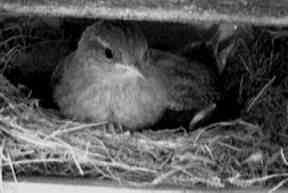
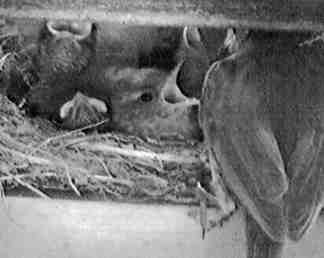
These images from early this evening show the mother robin waiting for a faecal sac to be produced and then taking it away. The first shot gives a rare chance to see beyond the fuzzy down that usually hides body detail on the chicks. You can see the bare areas between the bands of developing feathers on the chick's back and side.
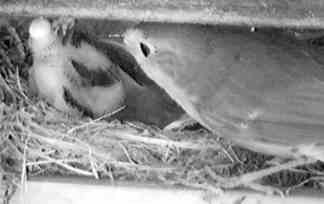
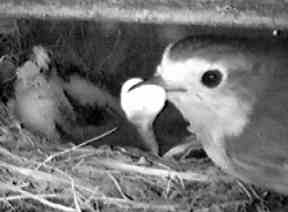
At 9.45pm the chicks seem to have the place to themselves after numerous visits from the wren in the course of the day. As the chicks are growing rapidly I guess space is getting too cramped for it to stay too long with this squirming bundle.
Friday 14 July - No opportunities to add to the diary properly today. There will be an entry later. The wren has been seen in the nest a couple of times today but there has been no sign of it this evening.
Saturday 15 July - Sorry, but the last couple of days I seem to have lost the plot as far as the diary has been concerned. A mixture of other jobs and chronic computer problems have distracted me too much. I am now two days behind in reviewing the videos that I have been making of the nest. I have added a picture of the wren being fed to Thursday's entry.
Anyway, the robins' chicks are doing fine and I have only seen the wren once today, soon after 7am. It is surprising how rapidly the chicks seem to have grown. today their feather coats show up a lot more and the downy 'halo' is gradually becoming less conspicuous. We have even seem some early testing of wings!
They hatched on the 4-5 July and my books give a period of 12-15 days before fledging. This means that they will be ready to fly anywhere between tomorrow and Wednesday, although I would be surprised to see them go anywhere tomorrow.
This evening we have been entertained by the largest flock of starlings I have seen here for a few years. Only a couple of months ago we were wondering why there were so few starlings about. They have disappeared now, I wonder where their roost is?
'Our' female blackbird has been injured again, this time on her left side and she is not looking very well. She can still fly this time (her right wing still droops after the last attack) but her right side appears swollen and feathers are damaged. She spent some time sitting on the grass in the sunshine this morning . We do not see the young blackbirds at all now, just the adult pair who are always eager to pinch the mealworms that I put out for the robins!
All is quiet in the nest now and at 9pm it looks as if feeding may be over for the day. Wrong, there were another 9 visits, the last one at 9.40pm.
Tommorow I will try to make sure that I add some images to the diary entry. I also need to reorganise things as we are now into week five.
Sunday 16 July - Almost a summer's day today, with a good bit of sunshine. Despite this the temperature under the trees only got to a maximum 19C after dropping to 9C last night.
The computer has been in use by the family most of today so I have not done the reorganisation as hoped, but I have just about caught up with the video reviewing.
Well, it looks as though the wren has finally left us. There have been no visits by it today and I have neither seen or heard it in the garden. The robin parents have been busy delivering food today and up to 4pm they visited the nest 176 times since the first feed at 4.15am. That would mean about 56 visits per chick. Nearly all the visits brought food to the nest so it is not surprising that they have grown so fast. It now looks crowded in the nest cup and they are certainly bigger than the wren now.
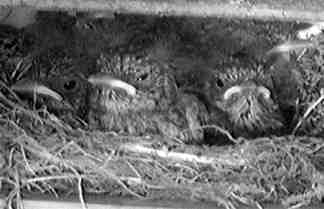
They still have the down that gives them a fuzzy look. However, they have a good covering of feathers and are covered by a pattern of rows of light blotches on a dark backround..
The left hand picture shows them huddled together at 10pm - the down shows up in the light from a lamp used with the external camera. the right hand picture was captured at 10.30pm after the lamp had been turned off. As the chicks settle for the night you can see the stripy patterns on them.
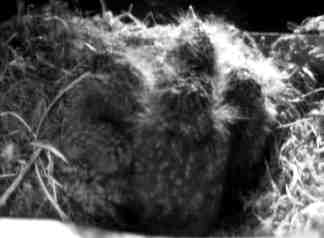
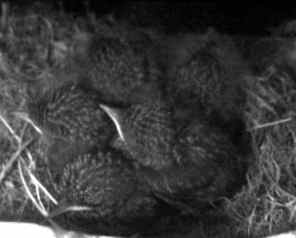
As I write this one chick has just been stretching its wings . The flight feathers look well developed.
None of the chicks has yet shown an interest in exploring beyond the nest rim.
Monday 17 July - A bright, sunny start to the day. The chicks still look cosy in their nest and there is no sign of the wren. This is day 13 for the first four chicks so I would expect to see some wing flapping today, but nothing as yet.
At 8.30am there has just been the loud alarm call of the male blackbird followed by the frantic chattering of the sparrows in my hawthorn tree and in the nest the chicks have taken a low profile.We have just had a visit from the sparrowhawk. I went out into the garden and could not see it but was greeted by the almost ear piercing high pitched squeek of the robin's alarm call. I shall go and check again in a moment to see if both robins are still safe.
I have just been watching our female blackbird trying to feed. She was having great difficulty picking up mealworms. I assume that she has lost the sight of one eye as her 3D vision has obviously failed. Every time she pecked at a worm she missed it by 3-5mm, pecking to the right each time. It does not look as though she will survive much longer. I have developed a great deal of respect for the way she survived an eventful nesting season and it will be a sad loss to the garden when she dies.
On the bright side. The chicks are, for the first time, making a lot of noise as a parent approaches with food. It sounds like a lot of rapid chattering on the TV. I will go down the garden and listen for myself later. Here are the five of them waiting for the next food delivery at 9.40am.
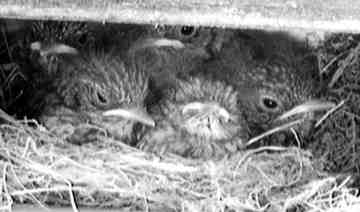
(I forgot to say yesterday that I weighed the robins again. This time the female weighed 17grams and the male slightly less at 16g. The male blackbird jumped onto the scales too and weighed 102g.)
During the late afternoon one of the parents took time off feeding to 'sun-bathe' on the garden fence. It positioned itself sideways to the sun, leaning slightly away from it, and fanned its tail out. It stayed this way for a couple of minutes.
At 6.20pm the nest, at first glance, appears empty. All five chicks have migrated to the other end of the nest-box, out of the range of the cameras. Only one chick is close to returning so far. In their absence the female has spent some time eating things off the bottom of the nest.
I have taken another look at the female blackbird. If a mealworm is orientated across her she is able to pick it up quite easily. The problem arises when the mealworm's body is aligned lengthways relative to her. Then she misses to the right by a couple of millimetres every time and soon gives up trying.
Tuesday 18 July - Another bright and sunny morning. The temperature by the nest dropped to 9C last night and is 18C at 9.30am.
The young robins are still in the nest but unfortunately they are still largely hidden from view. The inside camera has been moved slightly to enable us to see a couple of them. The down has all but vanished on the chick that I can see. I will have to make the box narrower for next year! They are still being fed although I get the impression that feeds are fewer in number this morning and only small insects (?) are being offered. I have not seen more than a couple of mealworms being taken.
For the first time I have heard chirping form the chicks. Although I cannot see much of them now, the microphone in the box is not picking up much activity, except for when the parents visit. I have not heard the sound of wings being tested so far this morning.
LATE NEWS - By 1.30pm today all five chicks had taken to the air and the nest is now empty!
As if in salute to the efforts of the robin parents we have just had a very timely fly-past by the RAF's Red Arrows aerobatics team (arriving to practice for the Farnborough Airshow next week).
5.30pm - I have just been reviewing the video recordings of first thing this morning and have come up with a surprise. I had seen four chicks leave the nest between 10am and 1.30pm. I assumed that I had somehow missed the fifth one. I even checked the nest. The early recording reveals that the first chick did not wait until dawn to leave. At 4.30 am it started wandering around the nest, perching on the brink a couple of times, before launching itself into the darkness at 4.32am! This was six minutes before the first visit from a parent. I had put a towel below the box in case of accidental departures so it would have had a soft landing if it went straight down!
The rest of the chicks remained largely out of sight at the side of the nest, being fed small amounts but at the same sort of frequency that we have seen over the last week with 10 - 12 visits per hour seeming to be the average. Then, at 10.04 a chick that had been completely hidden from me suddenly climbed over the others, flapped its wings, stood on the brink and was fed, and then headed out into what was by now a very bright world. The rest stayed put.
After 11am there were only another 6 feeding visits in the next hour and only three after 12 noon. The chicks were getting restless by 12.30 and there was chirping as they looked out, presumably for the next food delivery that was not going to come. Suddenly, at 12.59 the third chick hopped to the edge and was gone. A minute later and chick #4 followed it. The last chick was very reluctant to go and it was another five minutes before it followed the rest of its siblings into the trees.
Here are just two video images from the events of today. First, an adult makes one of the last visits to the nest. The second image shows chick #3, having reached its first perch outside the nest.
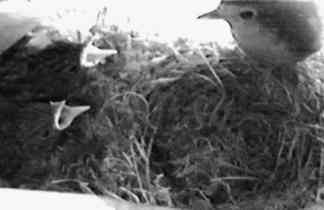
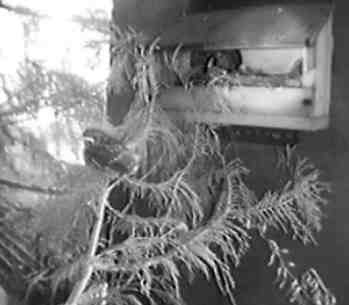
Here the last chick contemplates the future when the rest of the brood have gone. Look carefully and you may just see its spindly leg. What you cannot see are tail feathers. No wonder they are so unstable when they do try to fly!
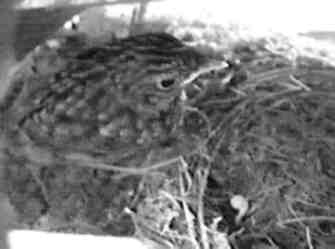
The fledglings are now spread out amongst the plants of the garden. I have sneaked a couple of photographs of three of them which I hope to get into the diary tomorrow.
Wednesday 19 July - It has been a warm, sunny day and the robin parents come for mealworms to take to the youngsters scattered in the surounding gardens. I have caught sight of two in the garden, hidden among the shrubs.
Here are a few colour photographs that I took over the last week. It has not been easy to get good pictures of the chicks as they grew up because I could not control the lighting conditions in the box without upsetting the parents, They were a lot more sensitive to disturbance than were the blue tits.
Because of this I stopped trying to take pictures inside the box. The first picture was my last attempt to do this. The halo of down that surounded the chicks at this stage made it quite difficult to see details on their bodies.
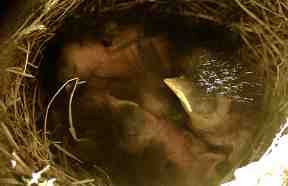
As we got to last weekend, the chicks spent a lot of time lined up at the front of the nest, looking out for the next feed, and greeting each delivery with wide gapes:
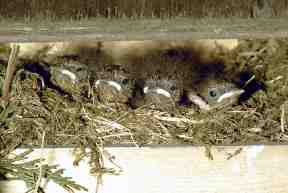
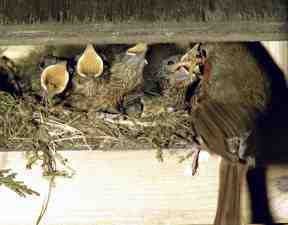
Finally, as they started on their maiden flights I sneaked as close as I could safely to chick #2 as it rested at the end of its first, short flight to a branch of a leylandii
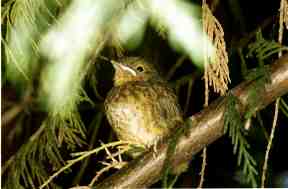
After that, it was a case of wishing them luck and leaving them in peace to find safe places to finish their growing up.
Click for large versions of these photographs
I must mention our female blackbird. Despite my pessimism she soldiers on. She limps on her left leg (the side that is injured) and she is reluctant to fly. However, she appears to be overcoming her problem in picking up mealworms and she manages to get most first time.
This afternoon I spent nearly ten minutes sitting on the ground feeding a house sparrow fledgling. It seemed to think that my thumb and finger constituted a parental beak and, having rejected seeds, enjoyed some wholemeal bread before wandering off for a drink and rejoining the other sparrows in the bushes. this evening we have been playing host to a wood pidgeon fledgling that has flown down into the garden and finds it difficult to fly up again.
Saturday 29 July - In the way of a postscript....
Now I only see one adult robin at any one time in the garden and I have not seen any sign of the chicks over the last week. There are still at least two hidden away somewhere in the neighborhood, as The adult that still comes for mealworms heads off in two different directions with them.
The female blackbird is looking a lot better now. She still limps on the left leg but the swelling on her left side has disappeared and she is moving about a lot more confidently.
This week has seen greenfinch youngsters chasing after their parents near our feeder. I cannot remember seeing this in the garden before. I shall have to watch for them through the next year to see if this is a one off or the start of a trend!
I have been reminded that the wood pidgeon fledgling that I mentioned in the last diary entry tried to land on the floating plants in my pond! The poor thing was, to saw the least, very confused.
The camera and sound equipment are all packed away now. After the summer I will start to make the changes to the birdbox(es) that have been suggested by this year's experiences.
I have enjoyed these last few months and I am glad to have had you sharing the developing story with me. It has been encouraging to receive e-mails of support and I am glad to see how it has helped some of you to follow what has been going on in nests in your gardens.
After a break from the diary for the next few weeks I hope to start looking again at the challenge of web site design in order to ????????????????!